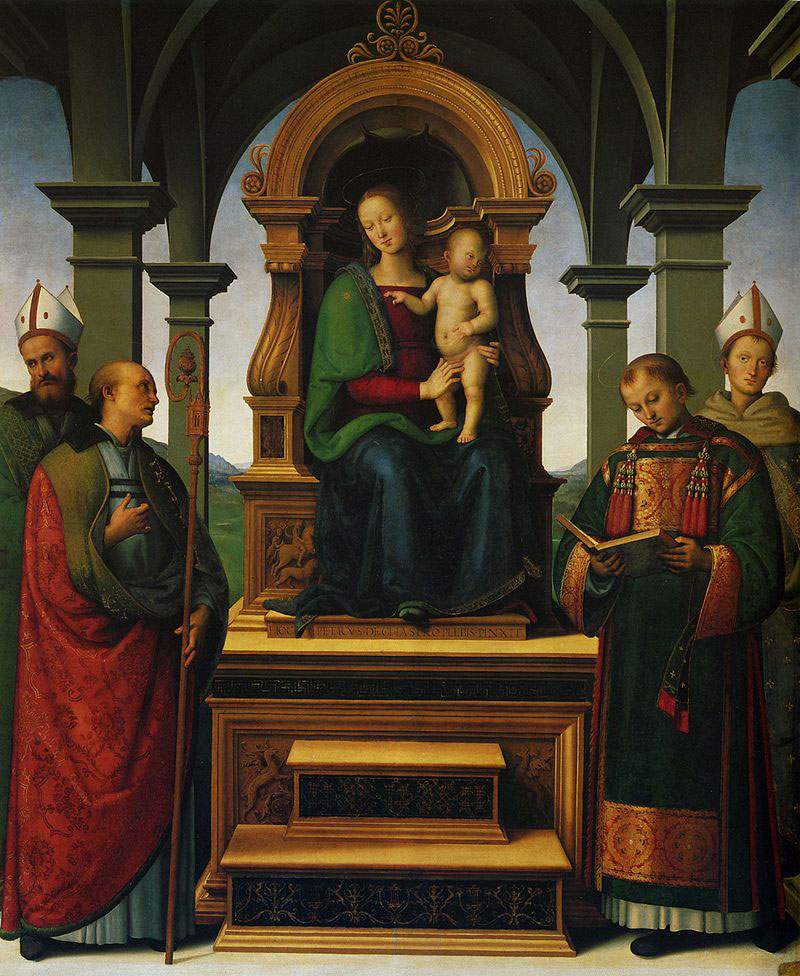Perugino's Decemvirs Altarpiece returns to its original location after two centuries
At the National Gallery of Umbria in Perugia, the Altarpiece of the Decemvirs by Pietro Vannucci, known as Perugino, returns after two centuries inside the Cappella dei Priori, and from October 11, 2019 to January 26, 2020, the public will be able to admire it.
In fact, thanks to the collaboration with the Vatican Museums and the curatorship of Barbara Jatta and Marco Pierini, visitors will have the opportunity to see the frame and cymatium, preserved at the National Gallery of Umbria, and Perugino’s central panel from the Vatican Museums, reunited in their original location.
The Cappella dei Priori was built in the mid-15th century and was finely decorated with a glazed majolica floor with floral motifs alternating with angels in flight and with famous pictorial cycles on the walls dedicated to the two patron saints, Herculaneum and Ludwig of Toulouse, created by Benedetto Bonfigli between 1454 and 1469. The wooden choir features inlays with griffins and plant motifs made by Gaspare di Giacomo da Foligno and Paolino di Ascoli.
Pietro Perugino was commissioned the Altarpiece of the Decemvirs for the altar: this depicts the Madonna and Child between Saints Herculaneum, Constantius, Lawrence and Ludovico. Herculaneum was the defensor civitatis from the siege of Totila who died in 549; Costanzo was the city’s first bishop martyred in the time of Marcus Aurelius; Lorenzo the patron saint to whom Perugia’s cathedral is dedicated; and Ludovico the protector of the Palazzo dei Priori, proclaimed a saint in 1317. The very iconography of the painting highlights its relevant role for the city as well. In fact, the work had previously been commissioned from Pietro di Galeotto, but due to his death, the commission was given to Perugino.
Perugino’s project also included the addition of a cymatium with the Madonna of Mercy, for which, due to the excessive protracted nature of the work, Sante di Apollonio was involved, who completed it completed in 1486; however, Perugino was called upon to repaint the cymatium the following year, as the Decemvirs wanted to celebrate the opening of the Monte di Pietà by having Christ in Pity depicted. The central panel, signed on the throne platform, was completed by Vannucci in 1495. The altarpiece remained in its original location until 1553, when the Cappella dei Priori was moved to a new location in other rooms of the Palace.
Later, following the Treaty of Tolentino, in 1797 the work was requisitioned by French troops and transferred to the Musée de la République, today’s Louvre. The French, however, ignored the cymatium with Christ in Pity and the carved and gilded wooden frame, the work of Giovanni di Battista di Cecco known as Il Bastone, which, after a stay at the Quadreria dell’Accademia in Perugia, returned to the Palazzo dei Priori. It was Canova, in 1816, who succeeded in bringing the panel back to Rome, which was kept in the Pinacoteca Vaticana.
The Pala dei Decemviri will be presented in 2020 at the Vatican Museums as an event as part of the celebrations of the 500th anniversary of Raphael’s death.
For info: https://gallerianazionaledellumbria.it
Hours: Tuesday through Sunday 8:30 a.m. to 7:30 p.m.; Monday noon to 7:30 p.m. (until Nov. 3). From November 3, 2019 Mondays closed.
Tickets: Full 8 euros, reduced 2 euros from 18 to 25 years old. Free up to 18 years old.
 |
| Perugino's Decemvirs Altarpiece returns to its original location after two centuries |
Warning: the translation into English of the original Italian article was created using automatic tools. We undertake to review all articles, but we do not guarantee the total absence of inaccuracies in the translation due to the program. You can find the original by clicking on the ITA button. If you find any mistake,please contact us.





























